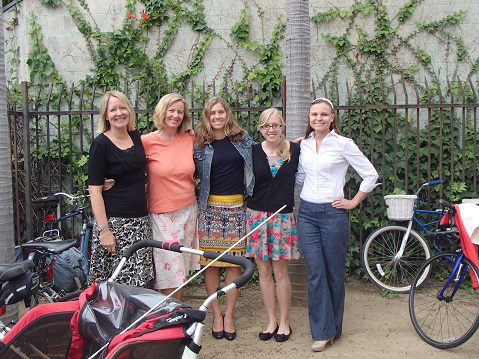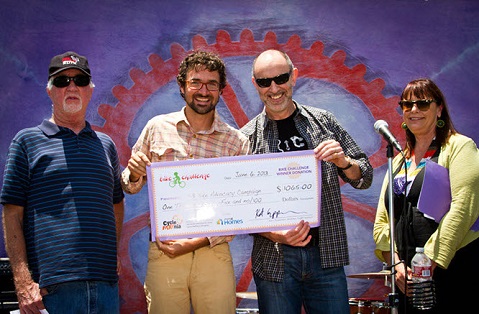Bike Challenge 2014
Traffic Solutions Encourages Santa Barbarans to Pedal More

This May, Santa Barbara Traffic Solutions will host its 10th annual Bike Challenge. The month-long event encourages residents to ride their bicycles for transportation. If the standard cycling benefits aren’t enough to get you pedaling, perhaps this friendly competition for a good cause might jump-start your ride.

During the Challenge, riders compete to earn donation dollars, prizes, and prestige. The event is sponsored by SBCAG (Santa Barbara County Association of Governments) and a part of CycleMAYnia, a collaborative celebration of cycling including fun events for all ages. Kent Epperson, director of Santa Barbara Traffic Solutions says, “The goal is to get more people on bikes.” Increased ridership is a part of the organization’s overall goal to “reduce traffic congestion and improve air quality.”
Judging by the numbers, last year’s event was a success. Over 500 people on 112 teams participated in the 2013 Bike Challenge. Traffic Solutions estimates that the event, which included over 5,500 bicycle trips, saved 53,000 pounds of pollution and $28,684 in commuter costs.
Teaming Up
Bike Challenge participants form teams of five riders. Teams may be composed of friends, relatives, coworkers, or even random Internet strangers. The idea behind forming small teams is to provide support and encourage camaraderie, “People are more motivated when doing things in groups,” says Epperson.
Lori La Riva, Traffic Solutions’ project coordinator agrees, “When you’re on a Bike Challenge team, your coworkers and friends are consistently there to cheer you on, laugh, and ride with you and help you get through pesky obstacles that make driving seem easier than biking.”
Newbies
Bike Challenge rules require at least two members per team to be “converts.” These are cyclists who are either new to the competition, or typically ride less than twice a week. Epperson says this is a great way to bring more people into the cycling community. “It’s a good excuse to recruit friends who don’t bike as much.”
For Santa Barbara County planner and longtime Bike Challenge participant Rosie Dyste, motivating new cyclists is a major appeal of the event. “I think the most beneficial part of the Challenge is getting people to try cycling who don’t normally cycle to work,” says Dyste. “The competition spurs people to try it, even if they normally don’t cycle on a regular basis.”
Christine Bourgeois’s experience supports this. In 2011 her team included a member who had only recently learned to ride a bike. “She loved the Challenge ,and at the end of the month, she was ‘converted’ to bike commuting,” says Bourgeois. “Today our ‘convert’ friend rides her bike to work as much as she can, and last year she became a certified League Cycling Instructor.”
Beating the Competition
Teams gain points by cycling around town and logging their trips on Traffic Solutions’ website. Qualifying trips may include biking to work, to the grocery store, to the movies, or to meet up with friends — anywhere you might be tempted to drive your car. Recreational rides, including mountain biking and unicycle practice, do not count.
Employers are encouraged to form teams and compete with similarly sized companies. Epperson says, “Scoring is based on a percentage, so if you’re a slightly smaller company, you’re still competing on a level playing field.”

Last years top ranking teams were The Road Hogs (City of Goleta), Green Vested Roadies (REI), and Da Rasta Roadrashers (Yardi Systems) with an impressive 4,933 miles cycled. Participation in the event can be a great way to improve employee health habits, free up parking, and boost morale.
Dyste enjoys the competitive atmosphere. “The best part is being on a team so you can encourage each other to ride more often to get points,” she says. “In Long Range Planning, it’s fun to try and beat other county teams, like Public Works.”
Pick Your Cause
The top 50 ranking teams receive money toward the charity of their choice. This year the benefiting organizations include iCan Bike, an adaptive bike camp for people with disabilities, the Foodbank of Santa Barbara County, the Campaign for Bikeways, and Santa Barbara Open Streets. Teams can earn up to $500 for the organization they’ve chosen.
Dyste is hoping to rank in the top 50 to help support Santa Barbara Open Streets, “I went to the first Open Streets and thought it was awesome. I think Santa Barbara should do this at least twice a year.”
The Rewards
The competition includes weekly prize drawings for gift certificates and gear. The more you pedal, the greater your chance of winning a prize. A culminating lunch with live music and an awards ceremony provides participants the chance to meet and celebrate their accomplishments.
For some, setting an example is reward enough. Sam Franklin is a first-time participant; he decided to join the challenge this year because, “I am passionate about cycling as a means of transport and would like to show it is very possible to be car independent, especially in Santa Barbara which is a great place for cycling.”
More Pedaling, Less Traffic
Through the Bike Challenge, Traffic Solutions hopes to help more Santa Barbarans see biking as a viable transportation method. Epperson believes the competition is a vast improvement over Bike-to-Work Day. “We were spending a lot of time and money on a single day, but we wanted to make lasting behavior changes,” he explains. “We knew there would be power in tapping into the competitive spirit. A month is enough time to shift travel behavior.” Traffic Solutions’ surveys as well as anecdotal evidence have supported this idea.
Epperson recognizes that biking to work is not feasible for everyone, but most of us can cut down significantly on car use by biking. “We know a lot of people can’t bike to work. Maybe the distance is too far, maybe they need their car during work-time hours,” he says. “But those people can still use the bike for transportation in other ways. Riding to the grocery store, coffee with friends, to a movie. All those count.”
Says Dyste, “The competition spurs people to try it, even if they normally don’t cycle on a regular basis. If they try it and like it, then it would benefit everyone by getting one more car off the road.”
Ready to take the Challenge? Log on to join an existing team or create a new one.



